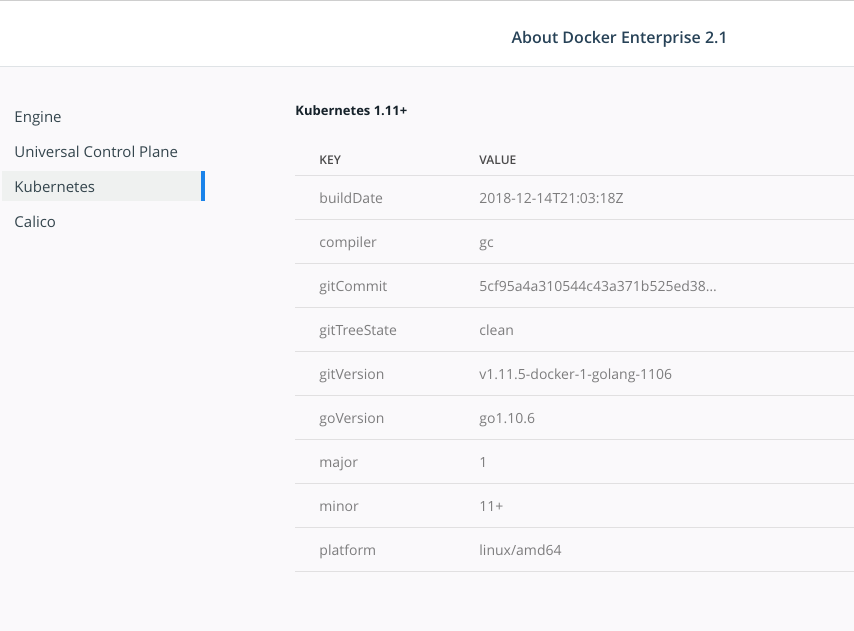Install the Kubernetes CLI
Estimated reading time: 3 minutesThis topic applies to Docker Enterprise.
The Docker Enterprise platform business, including products, customers, and employees, has been acquired by Mirantis, inc., effective 13-November-2019. For more information on the acquisition and how it may affect you and your business, refer to the Docker Enterprise Customer FAQ.
Docker Enterprise 2.0 and higher deploys Kubernetes as part of a UCP installation. Deploy, manage, and monitor Kubernetes workloads from the UCP dashboard. Users can also interact with the Kubernetes deployment through the Kubernetes command-line tool named kubectl.
To access the UCP cluster with kubectl, install the UCP client bundle.
Kubernetes on Docker Desktop for Mac and Docker Desktop for Windows
Docker Desktop for Mac and Docker Desktop for Windows provide a standalone Kubernetes server that runs on your development machine, with kubectl installed by default. This installation is separate from the Kubernetes deployment on a UCP cluster. Learn how to deploy to Kubernetes on Docker Desktop for Mac.
Install the kubectl binary
To use kubectl, install the binary on a workstation which has access to your UCP endpoint.
Must install compatible version
Kubernetes only guarantees compatibility with kubectl versions that are +/-1 minor versions away from the Kubernetes version.
First, find which version of Kubernetes is running in your cluster. This can be found
within the Universal Control Plane dashboard or at the UCP API endpoint version. You can also find the Kubernetes version using the Docker CLI. You need to source a client bundle and type the docker version command.
From the UCP dashboard, click About within the Admin menu in the top left corner of the dashboard. Then navigate to Kubernetes.

Once you have the Kubernetes version, install the kubectl client for the relevant operating system.
# Set the Kubernetes version as found in the UCP Dashboard or API
k8sversion=v1.11.5
# Get the kubectl binary.
curl -LO https://storage.googleapis.com/kubernetes-release/release/$k8sversion/bin/darwin/amd64/kubectl
# Make the kubectl binary executable.
chmod +x ./kubectl
# Move the kubectl executable to /usr/local/bin.
sudo mv ./kubectl /usr/local/bin/kubectl
# Set the Kubernetes version as found in the UCP Dashboard or API
k8sversion=v1.11.5
# Get the kubectl binary.
curl -LO https://storage.googleapis.com/kubernetes-release/release/$k8sversion/bin/linux/amd64/kubectl
# Make the kubectl binary executable.
chmod +x ./kubectl
# Move the kubectl executable to /usr/local/bin.
sudo mv ./kubectl /usr/local/bin/kubectl
You can download the binary from this link
If you have curl installed on your system, you use these commands in Powershell.
$env:k8sversion = "v1.11.5"
curl https://storage.googleapis.com/kubernetes-release/release/$env:k8sversion/bin/windows/amd64/kubectl.exe
Using kubectl with a Docker Enterprise cluster
Docker Enterprise provides users unique certificates and keys to authenticate against the Docker and Kubernetes APIs. Instructions on how to download these certificates and how to configure kubectl to use them can be found in CLI-based access.
Install Helm on Docker Enterprise
Helm is the package manager for Kubernetes. Tiller is the Helm server. Before installing Helm on Docker Enterprise, you must meet the following requirements:
- You must be running a Docker Enterprise 2.1 or higher cluster.
- You must have kubectl configured to communicate with the cluster (usually this is done via a client bundle).
To use Helm and Tiller with UCP, you must grant the default service account within the kube-system namespace the necessary roles. Enter the following kubectl commands in this order:
kubectl create rolebinding default-view --clusterrole=view --serviceaccount=kube-system:default --namespace=kube-system
kubectl create clusterrolebinding add-on-cluster-admin --clusterrole=cluster-admin --serviceaccount=kube-system:default
It is recommended that you specify a Role and RoleBinding to limit Tiller’s scope to a particular namespace, as described in Helm’s documentation.
See initialize Helm and install Tiller for more information.